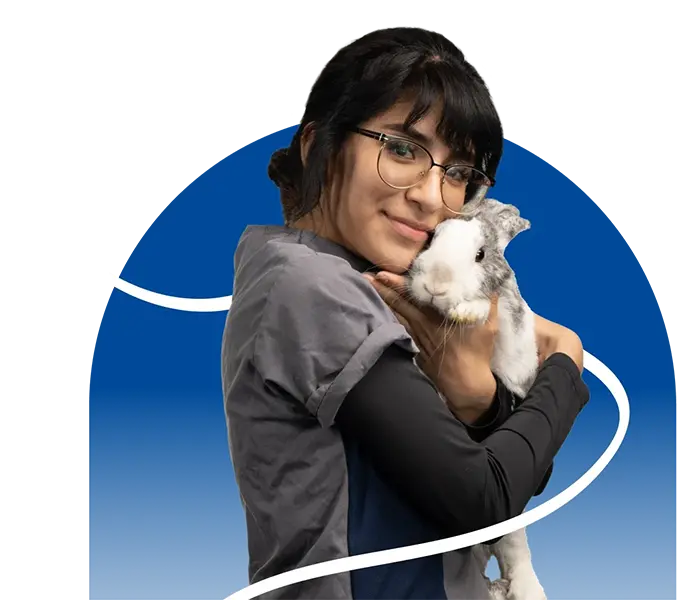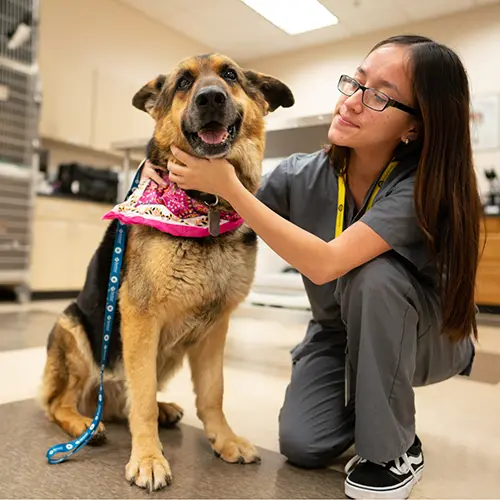Veterinary Assisting / Veterinary Assistant

Request Information
All fields using an asterik (*) are required.

Program Details
What Will I learn
Carrington College’s Veterinary Assisting program provides the clinical, laboratory, and administrative skills to support veterinarians in a variety of settings. Upon completion of the Veterinary Assisting program, graduates will be able to:
- Complete appropriate veterinary assisting procedures related to animal husbandry, diagnostics, equipment maintenance and client care in a variety of settings.
- Apply basic knowledge of animal anatomy and physiology of multiple species in relation to animal care.
- Maintain a professional and safe work environment.
Upon completion of the Veterinary Assistant program, graduates will be able to:
- Perform the duties pertaining to veterinary clinic reception, office management, and general computer skills.
- Perform the various duties of a veterinary assistant, such as venipuncture, administering of injections, placing of IV catheters, and the monitoring of anesthesia in a surgical setting.
- Perform dental prophylaxis, with capability to instruct and demonstrate in-home dental care, providing detailed explanation for future recommendations.
- Perform and apply laboratory procedures, as well as radiographic film processing regarded as diagnostic contributions in animal healthcare.
- Demonstrate confidence in the execution of exam room protocols, such as proper pet restraining techniques, obtaining vitals, accurate recording of patient history and client communication within the examination process.
- Relate and apply concepts of communication, reasoning, critical analysis, ethical behavior and appropriate interpersonal interaction to situations in his or her career and personal life.
- Demonstrate the social skills, professional appearance, attitudes and behavior that employers expect of graduates.
With comprehensive hands-on training and a strong foundation in veterinary care, this program prepares students for entry-level roles in veterinary clinics, hospitals, and animal care facilities.
Military Policy
Cost & Financial Aid
Your education is an investment in your future, and Carrington College is here to help. We offer a variety of financial aid options, including federal, state, and private programs, as well as student loans, grants, and scholarships are available for those who qualify. Each program has different requirements and application instructions. Our team is here to guide you through the options and application process.
Academic Cost
For complete details on current tuition costs, please refer to the Academic Catalog.
Location Availability
Carrington College’s Veterinary Assisting/Veterinary Assistant programs are available at multiple locations in Arizona, California, Oregon and Washington. Program availability varies by location. To learn more about each location, explore their location pages.
Accreditation & Approvals
Carrington College is accredited by the Accrediting Commission for Community and Junior Colleges, 428 J Street, Suite 400, Sacramento, CA 95814; 415 506 0234 an institutional accrediting body recognized by the Council for Higher Education Accreditation and the U.S. Department of Education. Additional information about accreditation, including the filing of complaints against member institutions, can be found at accjc.org.
For comprehensive information on Carrington College’s accreditation and approvals, visit carrington.edu/accreditation-and-approvals/.
Course Catalog
Program Specific Disclosures
Continuing Education For Graduates
Student Outcomes
Upon completion of the Veterinary Assisting program, graduates will be able to:
- Complete appropriate veterinary assisting procedures related to animal husbandry, diagnostics, equipment maintenance and client care in a variety of settings.
- Apply basic knowledge of animal anatomy and physiology of multiple species in relation to animal care.
- Maintain a professional and safe work environment.
REAL WORLD SKILLS
START YOUR PATH
FLEXIBLE LEARNING OPTIONS
AFFORDABLE TUITION
Milayna J.
2020 Veterinary Assisting Graduate

Veterinary Assistant Career Opportunities
According to the Bureau of Labor Statistics, increases in consumers’ pet-related spending are expected to drive employment in the veterinary services industry.1 In clinics and other veterinary service establishments, assistants help with various procedures. Demand for veterinary assistants will continue as the demand for these procedures increases.
What Will I Learn?
Veterinary Surgical and Assisting Techniques
Veterinary Hospital Practices
Animal Nursing and Care
Check out our guide on becoming a Veterinary Assistant.
Have you always wanted to work in a veterinary setting, but don’t want to attend school for years? Then a job as a veterinary assistant might be a good career for you. Veterinary assistants work in a variety of roles in veterinary offices and clinical settings supporting the licensed staff with technical tasks.
Discover What It’s Like to Train to Become a Veterinary Assistant at Carrington College
Veterinary Assisting / Veterinary Assistant FAQ
-
Carrington College’s hands-on Veterinary Assisting program can be completed in as few as nine months.
-
As stated by the BLS, veterinary assistants and laboratory animal caretakers are responsible for the following tasks:2
- Feeding, bathing, and exercising animals
- Cleaning and disinfecting cages, kennels, and examination and operating rooms
- Restraining animals during examination and laboratory procedures
- Maintaining and sterilizing surgical instruments and equipment
- Monitoring and care for animals after surgery
- Helping provide emergency first aid to sick and injured animals
- Giving medication or immunizations that veterinarians prescribe
- Assisting in collecting blood, urine, and tissue samples
-
Veterinary techs are qualified professionals that can perform higher-level clinical tasks to assist in diagnosing or treating animals, according to the American Veterinary Medical Association.2 Vet techs also typically have between two and four years of higher-level education, including an associate or bachelor degree. They must pass a credentialing exam and perform continuing education.
Vet assistants support veterinarians or veterinary technicians in their daily tasks and often perform clerical work. Some of their duties may include performing daily kennel functions, maintaining animals, or spending time on front-end tasks. A main difference between vet techs and vet assistants is that vet assistants complete clerical activities. Additionally, there are veterinary assisting training programs. Some others may learn training on the job, according to the AVMA.